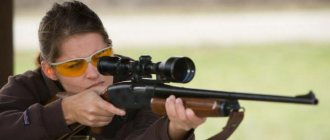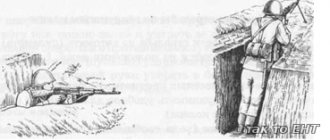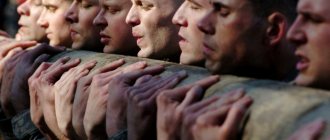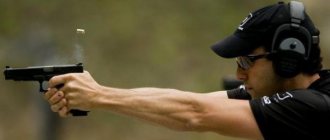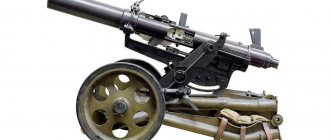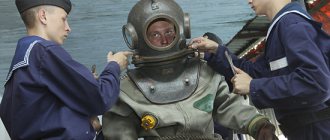Performing the first test firing exercise with an AK-74, AK-74M assault rifle.
When performing a shooting exercise, classes (training) are organized at training sites:
- Studying the requirements for implementing control systems from AK-74, AK-74M.
- Communicating the requirements for safety measures. The order of positioning and aiming.
- The procedure for assembling and disassembling AK-74, AK-74M.
When performing shooting exercises, soldiers and sergeants with field equipment (bag with magazines, gas mask, flask).
When performing a shooting exercise, officers and warrant officers must wear field uniforms and have a bag with magazines and a bag with hand grenades (if throwing hand grenades is planned).
Units arrive at the shooting range no later than 30 minutes before the start of shooting. This time is used to organize classes at training sites, check the operation of the mixing equipment and inspect the targets, and check communications with the shooting director.
Communication between the shooting director at the site and those firing from combat and other vehicles is carried out via radio; In the absence of radio communication, shooting is prohibited.
Before the start of shooting, the leader of the training (commander of the firing unit) informs the topic, purpose and order of the training, indicates on the ground the starting position, the boundaries of opening and stopping fire, the main and dangerous directions of shooting and checks the students’ significance of the conditions of the exercise being performed and safety measures during shooting.
When performing shooting exercises, the following order is observed: the platoon commander orders the commander of the firing squad to assign a combat mission to the trainees and receive and receive ammunition for the next shift of shooters at the ammunition supply point. Ammunition is issued to trainees individually according to a list or in stocked magazines. If necessary, ammunition can be dispensed by the ammunition dispenser in the original position. Trainees, having received ammunition, inspect them, load magazines with cartridges, put magazines in bags and, under the guidance of the squad commander (shift leader), proceed to their starting position.
Upon arrival of the shift at the starting position, the firing supervisor at the site clarifies to each shooter the procedure for performing the exercise (firing position, place and position for shooting, firing sector, direction of movement, order of firing of trainees, etc.).
Having made sure that the shift and the area are ready for shooting, the leader orders the red flag to be accepted at the local control point (open the red semicircles of the Armed Forces) and reports the readiness for shooting to the senior shooting leader.
When all areas are ready for firing, the senior firing supervisor orders the red flag to be raised at the command post and gives the order to give the signal “Listen, everyone.”
At this signal and at the command of the fire director “Forward to the indicated positions,” the trainees take up firing positions in accordance with the assigned task. Having made sure that the trainees are ready at the sites and that shooting is safe, the senior shooting director gives the order to give the “Fire” signal.
After the “ Fire ” signal, at the command of the firing supervisor at the “For battle” section, the trainee prepares to fire and reports: “ So-and-so is ready for battle ” - and at the command of the supervisor, they load the weapon. After the report on readiness for combat, the trainees, acting in accordance with the received task, observing in the specified sector of fire, independently detect and hit targets from the shooting positions provided for by the conditions of the exercise.
At the end of the exercise, the trainees load the weapon, the shooting director at the site inspects it, returns the shift to its original position, gives the order to replace the red flag at the local control point with a white one and hears a report from each trainee on his actions during the exercise, on observing the results of the shooting, on ammunition consumption, weapon malfunctions and delays.
Approximate form of the report: “ Comrade Senior Lieutenant, Private Sychev performed a test firing exercise from a machine gun; when firing, I observed: the machine gun was hit, the attacking infantry group was not hit, the cartridges were completely used up (not completely, there were so many cartridges left), there were no delays during shooting (there were such and such delays).”
After hearing the trainees' reports and making a brief review of the exercise, the shooting director orders them to hand over unspent ammunition to the ammunition supply point or ammunition distributor (if appointed) and proceed to the next training place. Then reports to the senior shooting supervisor about the end of the shooting shift.
After the shift returns to its original position (when white flags are displayed at all precinct control points), the senior shooting director gives the order to raise a white flag at the command post, give the “All clear” signal and, if necessary, inspect the targets (the shooting results are entered in the list, and the end of the firing of the entire unit - in the Firing Log).
During shooting exercises, the shooting director must be on site: on foot during the day - no closer than 15 m from the shooters, at night - no closer than 5 m.
When performing exercises from the spot, the shooting director at the site pre-plans 2-3 firing positions in each firing direction beyond the opening line of fire to a depth of 100 m. The movement of shooters to firing positions is carried out at the command of the firing leader, for example: “Firing position there - forward (to battle).”
The display of targets begins 10-20 seconds after the firing position is taken by the shooters. Fire stops and the weapon discharges upon the command " Cease fire, unload " given after the last target display time has elapsed.
Each subsequent target is displayed, as a rule, after the end of the display of the previous target. Options for displaying targets and firing positions (when performing standing shooting exercises) for each shift of trainees are determined by the shooting supervisor at the site or the inspector.
When shooting at night, the following additions are made to their organization and conduct:
When shooting at night without night sights, illumination and imitation of fire from targets (targets) is carried out in one of the possible ways. In this case, it is permitted to use self-luminous attachments on the sighting devices of weapons;
- when illuminating targets with lighting cartridges, at least 3 shooters are assigned per shift; illumination cartridges are released based on the illumination of targets throughout the entire time of their display (movement).
SHOOTING TRAINING EXERCISES
Shooting from a spot at emerging targets
Goals:
- machine gun crew (target No. 10 a), appearing for 30 seconds;
- attacking (retreating) infantry group - 2 life-size figures (target No. 8 a, b), located at different lines, imitate the movements (approach, distance) of the target; in this case, the farthest growth figure appears for 20 seconds, and the near one – for 15 seconds. with an interval of 10-20 seconds.
The interval between target displays is 10-20 seconds.
For a machine gun (5.45): machine gun crew - 300-250, height figures at the far line - 300-250, at the close line 200-150, number of cartridges 12 pcs., 3 of them with tracer bullets;
Fire training assessment
The individual assessment of a student's fire training is composed of marks for shooting and the importance of the fundamentals and rules of shooting and is determined:
- “excellent” , if the score for shooting is excellent, and for the understanding of the fundamentals and rules of shooting is not lower than good; for officers, both ratings are excellent;
- “good” if the mark for shooting is not lower than good, and for knowledge of the basics and rules of shooting is not lower than satisfactory; for officers, both ratings are at least good;
- “satisfactory” if both marks are not lower than satisfactory, or the mark for shooting is not lower than good, and the mark for knowledge of the basic rules of shooting is unsatisfactory; For officers, both ratings are at least satisfactory.
The mark for shooting is given based on the results of the last control shooting exercise, and the score for knowledge of the basics and rules of shooting is determined during control classes held before completing these shooting tests.
SAFETY REQUIREMENTS FOR HANDLING
WITH SMALL WEAPONS
During shooting
Before each loading of a weapon, make sure that there are no foreign objects (dirt) in the barrel;
load the weapon at the ceasefire line, with a control release and inspection of the weapon; loading and inspection of the weapon when firing from the BTR-80, BRDM-2рхб, РХМ is carried out without removing the muzzle of the barrel from the loophole or from the side;
when shooting at night on foot, have a signal light on the back of the shooters;
during live firing and tactical exercises with live firing, grenade launchers should be marked with flashlights and squad (platoon) flags; on BTR-80, BRDM-2рхб, РХМ, flashlights should be installed on the turret;
When malfunctions occur, crews should exit combat vehicles with the permission of the head of the exercise (training) and after the weapon is unloaded and given the maximum elevation angle;
at the end of the shooting, check the consumption of ammunition, remove unspent ammunition from personnel, inspect weapons, check magazines, boxes and tapes, and RAV service specialists inspect weapons installed on armored vehicles;
Do not fire:
- beyond the shooting directions or at a shelter (dugout) above which a red flag (lantern) is raised;
- anti-tank guided missiles (rocket-propelled grenades over units and in close proximity to them, as well as from all types of weapons against red lights;
before reaching the opening fire line;
after the “All clear” signal (the “Cease fire” command) and after raising the white flag (lantern) at the shelter (dugout), command post;
from faulty weapons or faulty ammunition;
It is strictly prohibited:
— load the weapon until the leader’s command and the “ Fire ” signal;
- point the weapon, regardless of whether it is loaded or not, at people, away from the direction of fire, to the rear of the shooting range;
- leave a loaded weapon and transfer it to other persons;
- finding people and leaving ammunition in the propagation sector of a grenade launcher jet stream closer than 30 m, resting the breech end of the grenade launcher barrel against any objects or soil;
- use grenades that have external damage, remove the safety caps from the fuses of combat grenades when firing in rain, hail or heavy snow;
— fire from a grenade launcher through bushes and tall grass;
- shoot from a machine gun from a trench with silent and flameless firing devices (SFS), ammunition not intended for these purposes;
Stop firing yourself immediately when:
— the appearance of people, cars and animals in target areas;
— the appearance of airplanes and helicopters in the firing plane;
— raising a white flag (lantern) at the command post (dugout);
— the occurrence of a fire on the target field;
— loss of orientation for the shooter;
- lagging behind the neighboring BTR-80, BRDM-2рхб, РХМ by more than 100m..
COMPLIANCE WITH FIRE TRAINING STANDARDS No. 3, 4, 5
Standard No. 3 - incomplete disassembly of weapons.
The weapon is on the mat, the tool is at the ready, the trainee is at the weapon. The standard is fulfilled by one trainee, evaluation indicators:
excellent good satisfactory
13 p. 14 p. 17 p.
Standard No. 4 - assembly of weapons after incomplete disassembly.
The weapon has been disassembled and is on the mat. Parts and mechanisms are neatly laid out, tools are at the ready. The student is at the weapon. The standard is fulfilled by one trainee. Estimated indicators:
excellent good satisfactory
23 p. 25 s. 30 s.
Standard No. 5 - equipping the magazine with cartridges
The trainee is located at the mat, on which there are magazines of training cartridges, a training grenade and a powder charge in a pencil case.
The student equips the magazine and attaches it to the weapon. Estimated indicators: magazine with 30 rounds.
excellent good satisfactory
30 s. 35 s. 40 s.
RESPONSIBILITIES OF PERSONS IN CONTROL OF SHOOTING
AND SUPPORTERS OF SHOOTING
1. The battalion commander or his deputy is usually appointed as the senior shooting leader. When shooting at a military shooting range of one company, the company commander is appointed as the senior shooting leader.
2. The senior shooting director is responsible for ensuring that shooting units comply with the established procedure, safety measures and conditions of the shooting exercises being practiced. The shooting managers at the sites and the personnel serving the shooting are subordinate to him. He is obliged:
a) on the eve of the shooting:
- study the order for organizing shooting and understand what exercises will be performed by the unit (which military units), the number of people firing from each type of weapon, the start and end time of shooting, from which unit (unit) officials are appointed to handle the shooting, the scope of preparation work target fields;
- appoint shooting leaders at the sites (when shooting from small arms);
b) before the start of shooting:
- accept reports from the commanders of the shooting units (shooting supervisors at the sites) on the readiness for shooting and the number of shooters by category, and from the head of the military shooting range (director) - on the readiness of equipment, operators, communications and alarm systems; from the head of the cordon - about the posted posts;
— give instructions to the shooting managers at the sites about the procedure for conducting shooting and remind them of safety measures;
- organize observation of the shooting and the target field, assign tasks to the observer and all officials assigned to serve the shooting;
- in the case when a general cordon is set up at the training center, obtain permission to fire from the head of the training center;
- after raising signals in all areas about readiness to fire, give an order to sound the sound signal “Listen everyone” and set up a corresponding visual signal at the command post;
- after reports from the shooting supervisors at the sites about the readiness of the shooting shifts for shooting and having made sure that there are no people, vehicles and animals on the target field, give an order to sound the “Fire” sound signal;
c) during shooting:
- monitor strict compliance with the requirements of the Shooting Course and avoid simplifications and relaxations when performing exercises;
- in cases of violations of security measures, the appearance of people, cars, animals on the target field or upon receipt of a report (signal) from the head (post) of the cordon about a violation of security measures, as well as when a white visual signal appears on the dugout (shelter) or other alarm signal at the command post and take measures to stop the shooting;
— know the results of shooting at the sites;
d) at the end of shooting:
- after raising white signals at all precinct control points, give an order to give the “Hang Up” signal and to replace the visual signal at the command post;
— accept reports from shooting supervisors at the sites on the results of shooting;
- report in the established order about the completion and results of the shooting;
- if the senior leader of the shooting is the commander of the shooting unit, then he conducts an analysis and gives instructions on further actions.
3. The commander of the shooting unit is appointed as the head of shooting at the site. He is responsible for strict compliance by the shooters with safety measures, established procedures, as well as the conditions of the exercise being performed. The operator of the target field control panel and all officials assigned to maintain shooting at the site are subordinate to him.
He is obliged:
a) before the start of shooting:
— communicate ceasefire signals to all unit personnel during firing exercises;
— check the compliance of the target equipment with the conditions of the exercise being performed and the availability of communication with the senior shooting director;
— check the readiness of classrooms for classes;
— organize observation of shooting;
— report to the senior firing supervisor about the readiness to fire, the number of shooters and set a red visual signal at the control point;
b) during shooting:
- direct the shooting at the site;
- if security measures are violated, immediately stop shooting and report to the senior shooting supervisor;
c) at the end of shooting:
— report to the senior shooting supervisor about the end of the shooting;
— organize the collection of spent cartridges;
— report to the senior shooting supervisor about the results of the shooting;
- conduct a shooting review with the unit and announce an assessment to each shooter and unit.
4. The doctor on duty (paramedic) performs duties as directed by the shooting director at the site (senior shooting director).
5. As a rule, a company sergeant major or a trained sergeant is appointed as the head of the combat feeding point.
He is obliged:
— know the rules for handling ammunition;
— monitor the correct inspection of ammunition by shooters, their preparation for firing and compliance with safety measures;
issue ammunition to the next shift of shooters (distributors) according to a list and accept unspent ammunition and cartridges from them according to the count (by piece);
- at the end of the shooting, report on the amount of remaining ammunition and, after delivering it to the warehouse, present the delivery note to the company commander.
6. Observers are appointed from the personnel of the firing unit. They are required to be at the command post, conduct observation in the specified sectors and report: on the appearance of people, vehicles and animals on the target field, low flying vehicles over the target field, on signals displayed on dugouts (shelters), on fires that have occurred on the target field in within the flight area.
7. All officials supervising and servicing shooting must have a bandage on their left on a white fabric on a semi-rigid basis, 30 - 40 cm long, 10 cm wide. An inscription is applied to the bandage in black paint or sewn from fabric, for example; “Head of shooting at the site.”
8. At the military shooting range, shooting director and firing camp there must be documentation:
— at the command post: instructions on safety measures, instructions to the senior shooting leader, head of the cordon, doctor (paramedic), observer; diagram of cordon posts, approved by the chief to whom the facility is subordinate; educational object form; a diagram of the facility indicating all its elements, boundaries, dimensions and available equipment; Logbook of shootings and trainings;
— at the local control point: instructions on safety measures, instructions to the director of shooting at the site; diagram of the site equipment indicating options for displaying goals, exercises being practiced, instructions for the operator.
If the shooting area is located separately from other areas and the shooting director there performs the duties of a senior shooting leader, then in addition to the above, there must be instructions for the paramedic and the head of the cordon; at the combat feeding point: instructions to the head of the combat feeding point; rules for handling ammunition; posters with samples of ammunition used at this combat supply point; distribution and delivery list for the issuance of ammunition.
“Firing from a spot at stationary and emerging targets during the day.”
| Goals | Range | Time | Number of used items | Shooting position | Initial settings |
| chest figure with circles (target 4) on a shield 0.75 x 0.75 motionless; the shield is installed at ground level (without clearance) | 100 m | unlimited | 3 pcs | lying down (see fig.) | Sight 4 Aiming point – the middle of the lower edge of the target with Pr – 4 exceeding the trajectory under. aiming line at D = 100 m – 24 cm |
| attacking (counterattacking) shooter - a life-size figure (target 8), appearing for an unlimited time | 200 m | unlimited | 8 pcs | lying down (see fig.) | Sight 4 |
| Aiming point – the middle of the target’s knee Exceeding the trajectory above the aiming line by D = 200 m – 38 cm | |||||
| Shooting assessment Hit both targets and at the same time knock out: “excellent” - 25 points, “good” - 20 points, “satisfactory” - 15 points |

